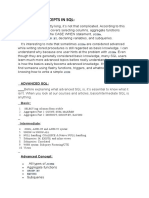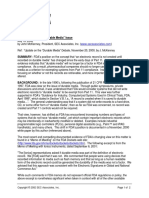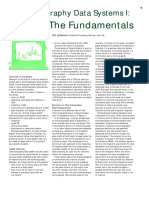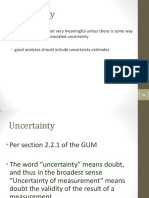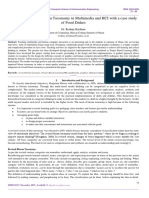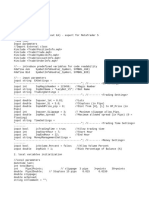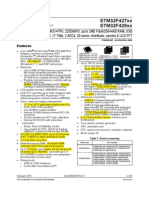Nitya CloudTech Pvt Ltd.
http://www.nityacloudtech.com/ @nityacloudtech
� Nitya CloudTech Pvt Ltd.
1. Calculate the Weighted Average of Scores for Each
Department
Interviewer:
How would you calculate the weighted average of scores for
each department?
Candidate:
Let’s assume the following table:
Table: Scores
Department StudentID Score Weight
HR 1 80 0.3
HR 2 90 0.7
IT 3 75 0.5
IT 4 85 0.5
SELECT
Department,
SUM(Score * Weight) / SUM(Weight) AS
WeightedAverage
FROM Scores
GROUP BY Department;
Result:
Department WeightedAverage
HR 87.0
IT 80.0
http://www.nityacloudtech.com/ @nityacloudtech
� Nitya CloudTech Pvt Ltd.
2. Find the Mode (Most Frequent Value) of a Column in a
Dataset
Interviewer:
How would you find the mode of a column in a dataset?
Candidate:
Let’s assume the following table:
Table: SurveyResponses
ResponseID Response
1 Excellent
2 Good
3 Excellent
4 Good
5 Good
SELECT
Response,
COUNT(*) AS Frequency
FROM SurveyResponses
GROUP BY Response
ORDER BY Frequency DESC
LIMIT 1;
Result:
Response Frequency
Good 3
3. Group Data by a Time Interval and Calculate Metrics
http://www.nityacloudtech.com/ @nityacloudtech
� Nitya CloudTech Pvt Ltd.
Interviewer:
How would you group data by a time interval (e.g., every 15
minutes) and calculate metrics?
Candidate:
Let’s assume the following table:
Table: SensorReadings
ReadingID Timestamp Value
1 2024-01-01 10:00:00 50
2 2024-01-01 10:10:00 60
3 2024-01-01 10:20:00 55
SELECT
DATEADD(MINUTE, DATEDIFF(MINUTE, 0,
Timestamp) / 15 * 15, 0) AS TimeInterval,
COUNT(*) AS ReadingCount,
AVG(Value) AS AverageValue
FROM SensorReadings
GROUP BY DATEADD(MINUTE, DATEDIFF(MINUTE,
0, Timestamp) / 15 * 15, 0);
Result:
TimeInterval ReadingCount AverageValue
2024-01-01 10:00:00 3 55.0
4. Aggregate Data with Multiple Levels of Grouping and
Custom Filters
Interviewer:
http://www.nityacloudtech.com/ @nityacloudtech
� Nitya CloudTech Pvt Ltd.
How would you aggregate data with multiple levels of
grouping and apply custom filters?
Candidate:
Let’s assume the following table:
Table: Sales
Region Product SalesAmount
North Laptop 2000
North Phone 1500
South Laptop 2500
South Phone 3000
SELECT
Region,
Product,
SUM(SalesAmount) AS TotalSales
FROM Sales
WHERE SalesAmount > 1500
GROUP BY Region, Product;
Result:
Region Product TotalSales
North Laptop 2000
South Laptop 2500
South Phone 3000
5. Calculate the Gini Coefficient for Income Inequality
Using SQL
http://www.nityacloudtech.com/ @nityacloudtech
� Nitya CloudTech Pvt Ltd.
Interviewer:
How would you calculate the Gini coefficient for income
inequality in SQL?
Candidate:
Let’s assume the following table:
Table: IncomeData
Individual ID Income
1 5000
2 7000
3 2000
WITH RankedIncome AS (
SELECT
Income,
SUM(Income) OVER () AS
TotalIncome,
SUM(Income) OVER (ORDER BY
Income) AS CumulativeIncome
FROM IncomeData
),
LorenzCurve AS (
SELECT
CumulativeIncome / TotalIncome AS
CumulativeShare
FROM RankedIncome
)
SELECT
http://www.nityacloudtech.com/ @nityacloudtech
� Nitya CloudTech Pvt Ltd.
1 - 2 * SUM(CumulativeShare -
LAG(CumulativeShare, 1, 0) OVER (ORDER BY
CumulativeShare)) AS GiniCoefficient
FROM LorenzCurve;
6. Use ROLLUP to Calculate Subtotals and Grand Totals
Dynamically
Interviewer:
How would you use ROLLUP to calculate subtotals and grand
totals dynamically?
Candidate:
Let’s assume the following table:
Table: Sales
Region Product SalesAmount
North Laptop 2000
North Phone 1500
South Laptop 2500
South Phone 3000
SELECT
Region,
Product,
SUM(SalesAmount) AS TotalSales
FROM Sales
GROUP BY ROLLUP(Region, Product);
Result:
Region Product TotalSales
http://www.nityacloudtech.com/ @nityacloudtech
� Nitya CloudTech Pvt Ltd.
North Laptop 2000
North Phone 1500
North NULL 3500
South Laptop 2500
South Phone 3000
South NULL 5500
NULL NULL 9000
7. Count Distinct Combinations of Two Columns
Interviewer:
How would you count the distinct combinations of two
columns?
Candidate:
Let’s assume the following table:
Table: Orders
OrderID CustomerID ProductID
1 101 P1
2 101 P2
3 102 P1
4 101 P1
5 102 P3
SELECT
COUNT(DISTINCT CONCAT(CustomerID, '-
', ProductID)) AS DistinctCombinations
FROM Orders;
http://www.nityacloudtech.com/ @nityacloudtech
� Nitya CloudTech Pvt Ltd.
Result:
DistinctCombinations
4
8. Group Data by a Derived Column Generated from a
CASE Statement
Interviewer:
How would you group data based on a derived column created
using a CASE statement?
Candidate:
Let’s assume the following table:
Table: Transactions
TransactionID Amount
1 100
2 200
3 500
4 50
5 300
SELECT
CASE
WHEN Amount < 100 THEN 'Low'
WHEN Amount BETWEEN 100 AND 300
THEN 'Medium'
ELSE 'High'
END AS AmountCategory,
http://www.nityacloudtech.com/ @nityacloudtech
� Nitya CloudTech Pvt Ltd.
COUNT(*) AS TransactionCount
FROM Transactions
GROUP BY
CASE
WHEN Amount < 100 THEN 'Low'
WHEN Amount BETWEEN 100 AND 300
THEN 'Medium'
ELSE 'High'
END;
Result:
Amount Category Transaction Count
Low 1
Medium 3
High 1
9. Find the Median Value of a Column Using SQL
Interviewer:
How would you calculate the median value of a column?
Candidate:
Let’s assume the following table:
Table: Scores
Student ID Score
1 70
2 80
3 90
4 85
5 75
http://www.nityacloudtech.com/ @nityacloudtech
� Nitya CloudTech Pvt Ltd.
WITH RankedScores AS (
SELECT
Score,
ROW_NUMBER() OVER (ORDER BY
Score) AS RowNum,
COUNT(*) OVER () AS TotalRows
FROM Scores
)
SELECT
AVG(Score) AS MedianScore
FROM RankedScores
WHERE RowNum IN (
(TotalRows + 1) / 2,
(TotalRows + 2) / 2
);
Result:
MedianScore
80.0
10. Calculate the Percentage Share of Each Category
Within a Group
Interviewer:
How would you calculate the percentage share of each
category within a group?
Candidate:
Let’s assume the following table:
http://www.nityacloudtech.com/ @nityacloudtech
� Nitya CloudTech Pvt Ltd.
Table: Sales
Region Product SalesAmount
North Laptop 2000
North Phone 1500
South Laptop 2500
South Phone 3000
SELECT
Region,
Product,
SalesAmount,
(SalesAmount * 100.0 /
SUM(SalesAmount) OVER (PARTITION BY
Region)) AS PercentageShare
FROM Sales;
Result:
Region Product SalesAmount PercentageShare
North Laptop 2000 57.14%
North Phone 1500 42.86%
South Laptop 2500 45.45%
South Phone 3000 54.55%
http://www.nityacloudtech.com/ @nityacloudtech
� Nitya CloudTech Pvt Ltd.
If you like the content, please consider supporting us by
donating using the QR code below. Your support helps us
continue creating valuable resources! Feel free to share this
with others who may benefit. Thank you for your support!
http://www.nityacloudtech.com/ @nityacloudtech


































